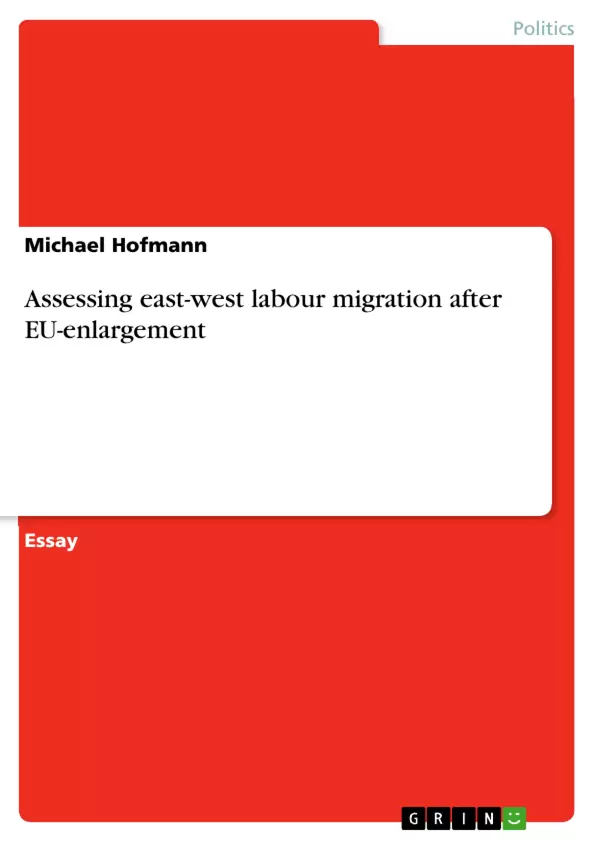On May 1, 2004, ten new countriesi joined the European Union (EU). Besides the Mediterranean countries of Cyprus and Malta, eight Central and Eastern European Countries (CEEC/EU-8) became members of the EU. The developments that lead to the enlargement in 2004 were accompanied by concerns in the fifteen old member states (EU-15) regarding the potential inflow of workers from the EU-8.
The Free Movement of Workers is a fundamental pillar of the EU’s internal market and is legally defined in Article 39 I of the Treaty of the European Community.ii According to this principle, every citizen of the EU is entitled to take up employment and to answer to job-offers EU wide. Some countries of the EU-15 feared that their labour markets were going to be flooded by Eastern European workers. Polish plumbers and Czech pavers, taking over the jobs of the EU-15 citizens, became symbols of the fear that was spreading in some EU-15 countries.
This essay will focus on two aspects: Firstly, it will examine whether the estimated migration scenarios prior to enlargement have been able to picture the current migration flows correctly. In a second step, the short- and medium-term impacts of EU-10 migration on the economies of the UK and Germany will be assessed. Whereas the former decided to allow migrant workers access to its labour market from the very beginning, the latter had chosen to restrict the free movement of workers and is currently considering extending these restrictions until 2009. It will be argued that the fears concerning negative economic effects in the UK were irrational – at least concerning the short-term impact. In regard to the German case, it will be argued that extending the restrictions until 2009 will have only a limitedly harmful effect on the economy.
Inhaltsverzeichnis (Table of Contents)
- I. Introduction
- II. East-West Labour Migration: Pre-Enlargement Assessments and Fears
- II A. Pre-Enlargement Assessments and Sentiments in Germany
- II B. Pre-Enlargement Assessments and Sentiments in the United Kingdom
- III. Post-Enlargement Labour Migration to Germany and the United Kingdom
- III A. Post-Enlargement Labour Migration to Germany
- III B. Post-Enlargement Labour Migration to the United Kingdom
- IV. The Economic Impact of EU-10 Labour Migration
- IV A. The Economic Impact: A short-term Consideration
- IV B. The Economic Impact: A medium-term Consideration
- V. Conclusions
Zielsetzung und Themenschwerpunkte (Objectives and Key Themes)
This essay aims to assess the impact of EU-10 labor migration on the economies of Germany and the United Kingdom. It will investigate whether pre-enlargement assessments accurately predicted migration flows and examine the short- and medium-term economic consequences of these flows. The paper focuses on the experiences of both countries in managing the influx of workers from the new EU member states.
- Pre-enlargement assessments and fears of EU-10 labor migration
- Actual migration flows to Germany and the United Kingdom after EU enlargement
- Short-term economic impact of EU-10 migration on Germany and the United Kingdom
- Medium-term economic considerations regarding the integration of EU-10 migrants
- The role of labor market flexibility and social welfare systems in managing migration
Zusammenfassung der Kapitel (Chapter Summaries)
- I. Introduction: Introduces the context of EU enlargement in 2004, highlighting the concerns surrounding the free movement of workers from the new member states. The essay outlines its focus on examining pre-enlargement predictions and the actual impact of migration on Germany and the UK.
- II. East-West Labour Migration: Pre-Enlargement Assessments and Fears: This chapter explores the sentiments and studies concerning potential migration flows to Germany and the UK before the EU expansion. It discusses public opinion polls, political statements, and research findings that estimated the scale of migration.
- III. Post-Enlargement Labour Migration to the UK and Germany: This chapter presents data on the actual migration flows to both countries after the EU expansion. It compares the actual figures with pre-enlargement predictions, highlighting the discrepancies and discussing reasons for the differences.
- IV. The Economic Impact of EU-10 Labour Migration: This chapter examines the economic consequences of EU-10 migration on Germany and the UK. It assesses the short-term impact on unemployment, employment rates, and welfare systems. The chapter also delves into the potential medium-term implications and challenges for both countries.
Schlüsselwörter (Keywords)
This essay focuses on the themes of East-West labor migration, EU enlargement, economic impact, labor market flexibility, social welfare systems, pre-enlargement assessments, and post-enlargement migration flows. The primary focus is on the experiences of Germany and the United Kingdom in managing the influx of workers from the new EU member states.
- Quote paper
- Michael Hofmann (Author), 2006, Assessing east-west labour migration after EU-enlargement, Munich, GRIN Verlag, https://www.grin.com/document/75611



